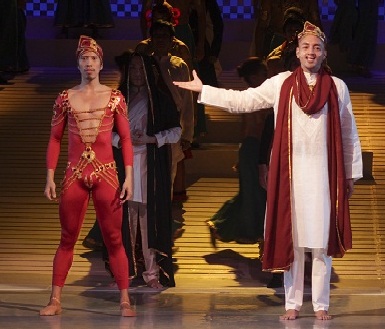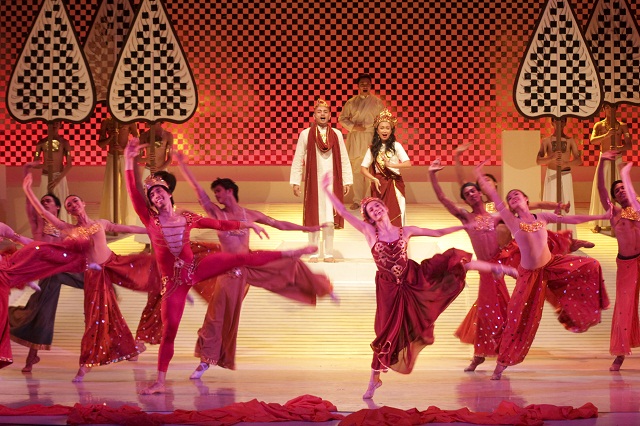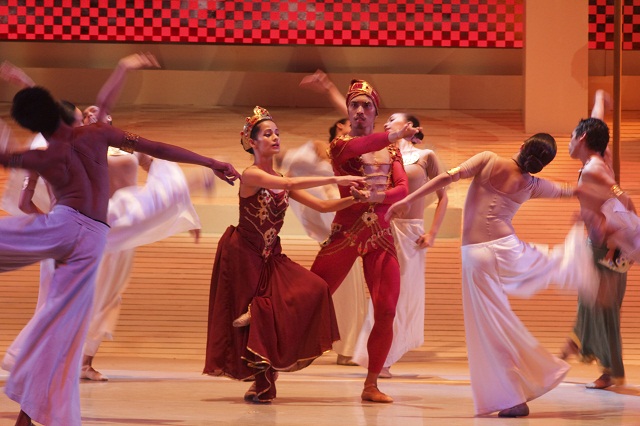Filtered by: Lifestyle
Lifestyle
Theater review: 'Rama Hari' a luminous collaboration of dancers and singers
By AMANDA LAGO, GMA NEWS

(L-R) Ballet Dancer Richardson Yadao (in red) and singer OJ Mariano; two Ramas in the 2012 Rama Hari
With music by Ryan Cayabyab, dances by choreographer Alice Reyes, libretto by National Artist for Literature Bienvenido Lumbera, and set and costumes by the late National Artist for Theater Design Salvador Bernal, expectations for the pop ballet musical "Rama Hari" were as high as the moon.
That the production was well-received when it was first staged 32 years ago—so well-received, in fact, that it even launched the career of Kuh Ledesma and made a Filipino favorite out of the love song "Magbalik Ka Na, Mahal"—only escalated the audience's excitement. Those who were behind the production this time around had not only a big stage to fill, but high hopes to fulfill.
Fulfill they did—at least for the most part—when it opened at the Cultural Center of the Philippines (CCP) on Nov. 30.
The stage was minimalist. It certainly was not something one would expect from a production based on the ornate and colorful Indian epic, Ramayana, a story of enduring love between the prince Rama, an incarnation of the god Vishnu, and the princess Sita, who would eventually become his wife.
But the choice for the stark set design turned out to be brilliant on the part of Bernal because it not only marked the production as a pop retelling of the ancient tale, but the plain white stage contrasted beautifully with the brightly colored costumes of the performers, and highlighted their movements and the shapes they made on stage.
Besides, the richly-embellished and jewel-toned costumes (which prompted an audience member to comment that even Filipino productions could match up to international plays like the recent run of “Phantom of the Opera”), fleet-footed choreography with its dramatic silhouettes, and the music that carried as much influence from Filipino love songs as Raga rock and Asian instrumentals did more than enough to bring an ethnic flavor. The production did not underwhelm, only impressed, from the moment the prologue began and the story's characters were introduced by the musical's big cast.
Each major character was represented by one dancer and one singer, and it might have been dizzying to the unassuming viewer if not for the color-coordinated costumes, the subtle inclusion of the singers into the choreography, and the performers themselves who were committed to exuding their respective characters whether through voice or through movement.

Lead dancers Richardson Yadao and Katherine Trofeo with lead singers OJ Mariano and Kalila Aguilos together with the Ballet Philippines
Bringing the characters to life became a collaborative effort between the singers and dancers. For the opening night, BP principal dancer Jean Marc Cordero and singer Christian Bautista came together as Rama, and BP dancer Carissa Adea and singer Karylle played Sita. Richardson Yadao and Robert Seña, on the other hand, played the demon Ravana, and Rita Angela Winder and Amparo Sietereales took on the role of the forest witch Soorpanakha.
There were times when the singer would outshine the dancer, or vice versa. For instance, in the scene where a besotted Soorpanakha tries to seduce Rama, Sietereales could barely be heard, which was a shame since her song “Type Kita, Rama” was one of the funnier musical numbers, and would have balanced oout the drama from the previous scenes quite nicely, and also because Winder's dancing as the lovelorn demoness was not only flawless, but commanding.
At their best however, the singers and the dancers would be equally stunning, so that the voices and movements seemed to almost melt into one entity.
Melanie Ligot's voice rose along with Charmaine Bianca Perez's shoulders as the proud queen Kaikeyi commanded her husband to send Rama into exile. Karylle's lilting song in “Ginoong Ermitanyo” translated into the shy sway of Adea's hips as Sita evaded Ravana's malicious touch. The desperate soaring of Bautista's vocals in “Tagistis ng Ulan” matched Cordero's forlorn leaps across the stage as Rama pined for Sita. The overall effect was breathtaking.

(L-R) Katherine Trofeo as Sita and Richardson Yadao as Rama
The Manila Symphony Orchestra provided the music for the show, with Jeffrey Solares conducting and Jed Balsamo as musical director. Their faultless playing was invisible but central to setting the mood for each scene. Vocalists from the UP Concert Chorus in particular gave great support to the main singers, and added great texture to each song number.
Of course, there were a few misses. The supertitles hardly did justice to Rolando Tinio's translation of Lumbera's libretto, with one too many misspelled words and typographical errors. They were ill-timed too, and inconsistent.
Also, there were times when the stage would be overcrowded, and the surplus of dancers and singers on stage distracted from their movements. Truly, the musical was at its best during the quieter scenes, when only a handful of characters would be on stage.
Another weak point was the shadow play. It's easy to appreciate its inclusion in the musical as a nod to an ancient Asian art form, but the execution made what could have been an exciting fight scene anti-climactic, mainly because it was unclear who was winning the fight.
Ultimately though, this year's production of “Rama Hari” is a winning production, not only because it is great material to begin with, but because the team behind it today took great care of the legacy that luminaries Reyes, Cayabyab, Lumbera, and Bernal started many years ago. —KG/HS, GMA News
"Rama Hari" will run at the CCP Main Theater from November 30 to December 9, 2012. For inquiries, call Ballet Philippines at (02) 551-1003, or visit www.ballet.ph or www.facebook.com/balletphilippines. All photos by Jerome Bonto courtesy of Ballet Philippines
Find out your candidates' profile
Find the latest news
Find out individual candidate platforms
Choose your candidates and print out your selection.
Voter Demographics
More Videos
Most Popular





